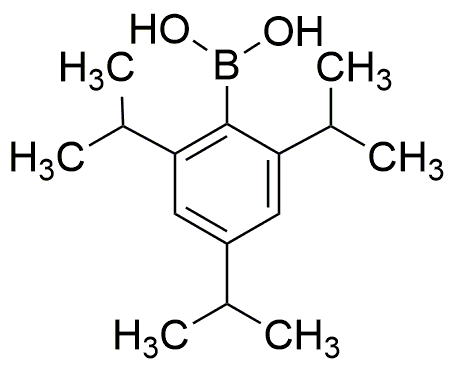2,4,6-Triisopropylphenylboronic acid is widely utilized in research focused on:
- Organic Synthesis: This compound serves as a versatile building block in organic chemistry, facilitating the formation of complex molecules through Suzuki coupling reactions, which are essential for creating pharmaceuticals and agrochemicals.
- Drug Development: In medicinal chemistry, it plays a crucial role in the design of boron-containing drugs, which can enhance the efficacy and selectivity of therapeutic agents, particularly in cancer treatment.
- Material Science: It is used in the development of advanced materials, such as polymers and nanomaterials, where its unique properties can improve mechanical strength and thermal stability.
- Bioconjugation: The compound is valuable in bioconjugation techniques, allowing researchers to attach biomolecules to surfaces or other molecules, which is vital for diagnostics and targeted drug delivery systems.
- Environmental Applications: It can be utilized in the detection and removal of pollutants, as its boronic acid functionality can selectively bind to certain environmental contaminants, aiding in water purification processes.
General Information
Properties
Safety and Regulations
Applications
2,4,6-Triisopropylphenylboronic acid is widely utilized in research focused on:
- Organic Synthesis: This compound serves as a versatile building block in organic chemistry, facilitating the formation of complex molecules through Suzuki coupling reactions, which are essential for creating pharmaceuticals and agrochemicals.
- Drug Development: In medicinal chemistry, it plays a crucial role in the design of boron-containing drugs, which can enhance the efficacy and selectivity of therapeutic agents, particularly in cancer treatment.
- Material Science: It is used in the development of advanced materials, such as polymers and nanomaterials, where its unique properties can improve mechanical strength and thermal stability.
- Bioconjugation: The compound is valuable in bioconjugation techniques, allowing researchers to attach biomolecules to surfaces or other molecules, which is vital for diagnostics and targeted drug delivery systems.
- Environmental Applications: It can be utilized in the detection and removal of pollutants, as its boronic acid functionality can selectively bind to certain environmental contaminants, aiding in water purification processes.
Documents
Safety Data Sheets (SDS)
The SDS provides comprehensive safety information on handling, storage, and disposal of the product.
Product Specification (PS)
The PS provides a comprehensive breakdown of the product’s properties, including chemical composition, physical state, purity, and storage requirements. It also details acceptable quality ranges and the product's intended applications.
Certificates of Analysis (COA)
Search for Certificates of Analysis (COA) by entering the products Lot Number. Lot and Batch Numbers can be found on a product’s label following the words ‘Lot’ or ‘Batch’.
*Catalog Number
*Lot Number
Certificates Of Origin (COO)
This COO confirms the country where the product was manufactured, and also details the materials and components used in it and whether it is derived from natural, synthetic, or other specific sources. This certificate may be required for customs, trade, and regulatory compliance.
*Catalog Number
*Lot Number
Safety Data Sheets (SDS)
The SDS provides comprehensive safety information on handling, storage, and disposal of the product.
DownloadProduct Specification (PS)
The PS provides a comprehensive breakdown of the product’s properties, including chemical composition, physical state, purity, and storage requirements. It also details acceptable quality ranges and the product's intended applications.
DownloadCertificates of Analysis (COA)
Search for Certificates of Analysis (COA) by entering the products Lot Number. Lot and Batch Numbers can be found on a product’s label following the words ‘Lot’ or ‘Batch’.
*Catalog Number
*Lot Number
Certificates Of Origin (COO)
This COO confirms the country where the product was manufactured, and also details the materials and components used in it and whether it is derived from natural, synthetic, or other specific sources. This certificate may be required for customs, trade, and regulatory compliance.


